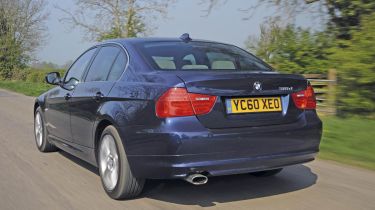BMW 320d M Sport
With strong pace and great efficiency, class leader will be tough to beat
If one car has haunted the C-Class, it’s the 3-Series. It has been a thorn in its side ever since Mercedes launched its first compact executive in 1982. Back then, the BMW was famed for its driver involvement – and if you fast forward nearly three decades, it’s now established as a class leader. Not only that, but the 3 is also a firm fixture in the top 10 of the UK’s new car sales chart.
The styling has evolved down the years, and the no-nonsense lines blend with the classic double kidney grille to create an attractive well proportioned shape. Switch to M Sport trim (not pictured), and racier bumpers, lower suspension and bigger wheels give the looks a sportier edge to rival the C-Class flagship.
[[{"type":"media","view_mode":"content_narrow","fid":"68657","attributes":{"alt":"","class":"media-image"}}]]
Inside, you’re greeted by a solid and shapely dash with a logical layout – the simplicity of the dials and switchgear is a real highlight. There are cheap plastic panels and blanked-off buttons low down on the centre console, but the excellent front seats offer lots of adjustment and a purposefully low-slung driving position.
However, it’s once you get moving that the BMW really starts to impress. All the controls are perfectly weighted and, in corners, the steering is alive with feedback that’s missing from the C-Class. There is some body movement, but it’s very well controlled, and the keen responses mean the 320d feels more agile than the Mercedes. This alertness, combined with the rear-driven purity that the Audi lacks, gives the BMW a clear dynamic advantage.
The trade-off in M Sport trim comes over uneven surfaces, as the ride is firm. However, this is a criticism that can be levelled against all three of the flagship models in this test.
Despite the hard edge, the 320d combines strong performance with refinement. Road and wind noise are minimal, while the 2.0-litre engine is smoother than the Mercedes’ unit. It revs cleanly and quickly, and a snappy shift and punchy in-gear responses make it a real joy to use.
The 320d’s performance doesn’t come at the expense of economy or emissions. Other manufacturers may be catching up with BMW’s pioneering stop-start, brake regeneration and energy-saving systems, but the 3 remains the class leader. Low CO2 emissions of 125g/km ensure it’s cleaner than rivals – although, unlike the Mercedes, choosing the optional automatic gearbox sees the output rise by some margin: up to 140g/km.
Business users should stick with the slick manual. They won’t be left wanting for standard kit, either, as rear parking sensors, cruise control and climate functions are all fitted as standard. Bluetooth is a £250 option, but such is the BMW’s all-round appeal, this is unlikely to be a deal breaker.
Details
Chart position: 1
WHY: The 3-Series is great to drive, fuel efficient and upmarket, as well as stylish, and has set a high benchmark in the compact executive class for decades.







